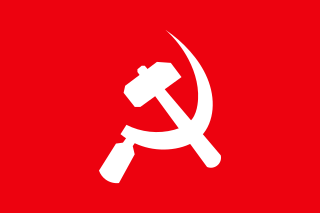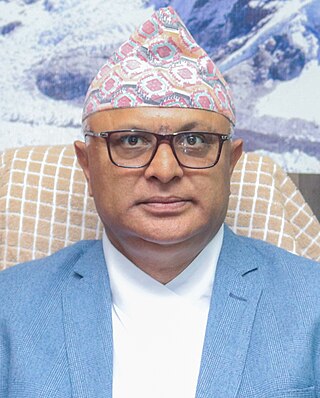
Pushpa Kamal Dahal, alias Prachanda, is a Nepalese politician currently serving as the Prime Minister of Nepal. He previously held the prime ministerial post from 2008 to 2009 as the first prime minister of the Federal Democratic Republic of Nepal, and again from 2016 to 2017. He was elected as prime minister for the third time in 2022, following that year's elections.

The Communist Party of Nepal (Maoist Centre) (Nepali: नेपाल कम्युनिस्ट पार्टी (माओवादी केन्द्र)), abbreviated CPN (Maoist Centre), CPN-Maoist Centre, CPN Maoist Centre, or CPN (MC), is the third largest political party in Nepal and a member party of Samajbadi Morcha. It was founded in 1994 after breaking away from the Communist Party of Nepal (Unity Centre). The party launched an armed struggle in 1996 against the Nepalese government. In 2006, the party formally joined mainstream politics after signing a peace agreement following the 2006 Nepalese revolution.

The Communist Party of Nepal (Unified Marxist–Leninist) (Nepali: नेपाल कम्युनिष्ट पार्टी (एकीकृत मार्क्सवादी-लेनिनवादी), romanized: nēpāl kamyuniṣṭ pārṭī (ēkīkṛt mārksavādī-lēninavādī); abbr. CPN (UML)) is a communist political party in Nepal. The party emerged as one of the major parties in Nepal after the end of the Panchayat era.

The Nepal Communist Party, abbreviated NCP is a defunct communist party which existed in Nepal from 2018 to 2021. It was founded on 17 May 2018, from the unification of two leftist parties, Communist Party of Nepal and Communist Party of Nepal. The unification was completed by the Party Unification Coordination Committee, after eight months of negotiation. The two predecessor parties subsequently dissolved, making way for the new united party. The party retained the electoral symbol of the CPN (UML), the sun.

Khadga Prasad Sharma Oli is a Nepali Communist politician who formerly served as Prime Minister of Nepal. He has served two terms as prime minister, from 11 October 2015 to 3 August 2016, and from 15 February 2018 to 13 July 2021, the first prime minister to be appointed following the first general election under the new constitution.

The Oli cabinet, 2018 was the Government of Nepal from 15 February 2018 to 13 July 2021. It was initially formed as a majority coalition on 15 February 2018, after Khadga Prasad Sharma Oli was elected as the new Prime Minister of Nepal following the 2017 general election. Oli's candidacy was supported by the Communist Party of Nepal and the Communist Party of Nepal. He assumed his office along with two ministers with the remaining ministers added at later points. The CPN withdrew its support from the government in May 2021, reducing it to a minority, and after the dissolution of the House of Representatives, it turned into an interim government. The Oli cabinet, 2018 was replaced by the fifth Deuba cabinet, formed after the Supreme Court ordered the appointment of Nepali Congress president Sher Bahadur Deuba as prime minister under in accordance with Article 76 (5) of the Constitution of Nepal.

The First Federal Parliament of Nepal, consisting of the House of Representatives and the National Assembly, was elected via the 2017 legislative, provincial and local elections.

The Minister of Health and Population is the head of the Ministry of Health and Population. One of the senior-most officers in the Federal Cabinet, the minister is responsibility for overall policy formulation, planning, organisation and coordination of the health sector at national, province, district and community levels. The Minister is assisted by the Minister of State for Health and Population and the junior Deputy Minister of Health and Population.

General elections were held in Nepal on 20 November 2022 to elect the 275 members of the House of Representatives. There were two ballots in the election; one to elect 165 members from single-member constituencies via FPTP, and the other to elect the remaining 110 members from a single nation-wide constituency via party-list proportional representation.

The Fifth Deuba cabinet was the Government of Nepal from 13 July 2021 to 26 December 2022. It was formed after Sher Bahadur Deuba was appointed as the new prime minister of Nepal by president Bidya Devi Bhandari following an order from the Supreme Court, which declared the dissolution of the House of Representatives on the recommendation of former prime minister KP Sharma Oli to be unlawful. The fifth Deuba cabinet was replaced by the Dahal cabinet, 2022 on 26 December 2022, when Pushpa Kamal Dahal's CPN broke away from the electoral alliance with Nepali Congress and joined hands with other opposition parties to form a government in the aftermath of the 2022 general election.

The Loktantrik Samajwadi Party, Nepal, is the sixth largest political party in Nepal. The party was officially registered at Election Commission, Nepal on 18 August 2021. Mahantha Thakur is the president of the new party. The party was formed after split in PSP-N to join KP Oli led government. Currently, the party stands as the fourth largest party of Madhesh province after Nepali Congress, CPN (UML) and Janata Samajbadi respectively.

At the end of 2020, a major split in the Nepal Communist Party (NCP) revived the Communist Party of Nepal and the Communist Party of Nepal.
Municipal election for Bharatpur took place on 13 May 2022, with all 147 positions up for election across 29 wards. The electorate elected a mayor, a deputy mayor, 29 ward chairs and 116 ward members. An indirect election will also be held to elect five female members and an additional three female members from the Dalit and minority community to the municipal executive.

The Second Federal Parliament of Nepal, was elected by the 2022 general elections on 20 November 2022. The elections elected 275 Members of Parliament (MPs), 165 for each constituency and 110 through the party list, to the House of Representatives. The parliament convened for the first time on 9 January 2023.
The 2nd Koshi Provincial Assembly was elected through the provincial elections held on 20 November 2022. The assembly has 56 constituency seats in which members are elected through direct elections and 36 proportional representation party list seats. The term of the assembly is 5 years unless dissolved earlier. The first session of the assembly commenced from 1 January 2023.
The 2nd Madhesh Provincial Assembly was elected through the provincial elections held on 20 November 2022. The assembly has 64 constituency seats in which members are elected through direct elections and 43 proportional representation party list seats. The term of the assembly is 5 years unless dissolved earlier. The first session of the assembly started from 2 January 2023.
Events in the year 2023 in Nepal.

The Minister of Women, Children and Senior Citizens is the head of the Ministry of Women, Children and Senior Citizens of the Government of Nepal. One of the senior-most officers in the Federal Cabinet, the minister is responsibility to formulate policies for social and economic empowerment to promote the role of women, children, senior citizens and various sections of the society in the sustainable peace and development of the country.

The Minister of Land Management, Cooperatives and Poverty Alleviation is the head of the Ministry of Land Management, Cooperatives and Poverty Alleviation of the Government of Nepal. One of the senior-most officers in the Federal Cabinet, the minister is responsibility to establish good governance by upgrading judicial access, feeling of security of land ownership, and effectiveness of service effluence in country.

The Third Hikmat Karki cabinet is the current and 9th provincial government of Koshi Province. It was formed after Hikmat Kumar Karki was sworn in as Chief Minister of Koshi Province on 9 May 2024.















